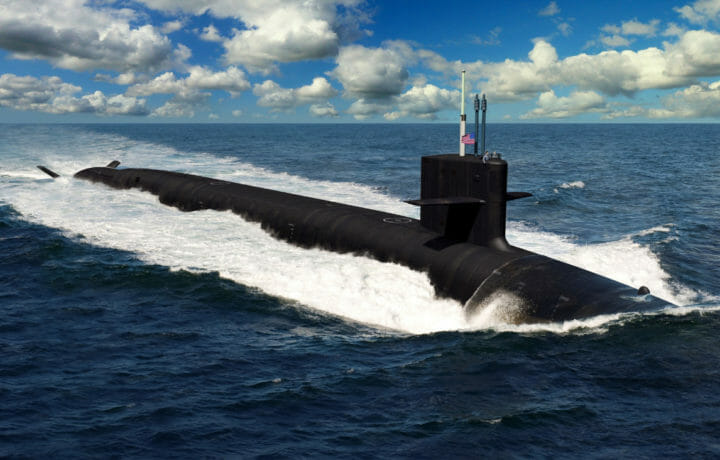The United States Navy currently operates 14 aging Ohio-class ballistic missile submarines (SSBNs), which were built between 1976 and 1997. In addition, four of the oldest submarines of the class were converted to cruise missile submarines (SSGN) as part of the Strategic Arms Reduction Treaty (New START) with the Russian Federation. As those SSBNs are expected to reach the end of their expected life before the end of the decade, the U.S. Navy has identified the Columbia-class program as a top priority.
The SSBNs are a key component of the United States military’s nuclear triad, and a serious concern is that a shortage of boats could impact the nation’s nuclear deterrent capabilities.
According to a new Congressional Research Service report, “Navy Columbia (SSBN-826) Class Ballistic
Missile Submarine Program: Background and Issues for Congress” updated January 15, 2021, the Navy wants to fast-track the program and procure the first of the boats in fiscal year 2021 (FY21). While that may seem to be overly optimistic, research and development work on the program has been underway for several years. Advance procurement (AP) funding for the first boat even began in FY2017.
The CRS report suggested that excluding costs for plans, the estimated hands-on construction cost of the first ship is $8.4 billion.
The Navy has also set a goal to procure the second Columbia-class submarine in FY2024, while the Navy’s FY21 budget submission has estimated that the total procurement cost for the 12-ship class would be $109.8 billion in then-year dollars.
Issues for Congress
The report from the CRS also identified several issues that Congress may need to address. Top among them the risk due to the still ongoing Covid-19 pandemic, along with technical challenges and/or funding-related issues could lead to the design and building of the lead Columbia-class boat. That could put the Navy’s ability to have the ballistic missile submarine ready for its first scheduled deterrent patrol in 2031 – when the first of the Ohio-class SSBNs is set to retire – at risk.
The report also called into question whether the U.S. Navy has accurately priced the work it has proposed for the program, as well as the risk of cost growth in the program. The report warned of the potential impact that the Columbia-class program could have on funding for other programs, including other shipbuilding programs.
CRS also noted the potential industrial-base challenges of building both the Columbia-class SSBNs and the Virginia-class attack submarines (SSNs) at the same time.
The GAO Take
It wasn’t just the CRS that has put the Navy’s Columbia-class program in the spotlight. This month, the Government Accountability Office also released its own report, “Columbia Class Submarine: Delivery Hinges on Timely and Quality Materials from an Atrophied Supplier Base.”
It noted that in previous building booms, there had been more suppliers available to the nation’s nuclear shipbuilders than are available today. The GAO stressed, “The Columbia class program’s success is contingent on timely delivery of quality materials, but quality problems with some materials caused delays during early construction.”
The GAO recommended that the Navy provide Congress with supplier readiness information and reassess when to conduct inspections at supplier facilities to limit quality problems.
A Larger Navy
Both new classes of submarines are just one part of the U.S. Navy’s efforts to expand to address the threat from an increasingly capable Chinese People’s Liberation Army Navy (PLAN), which surpassed the United States Navy as the largest naval force in the world.
China’s current naval fleet numbers 350 warships compared to the United States Navy’s 293 vessels, and the Pentagon expects the number of PLAN warships to increase to at least 360 by the end of the decade, but in addition to numbers it will be a more modern force that includes aircraft carriers and submarines with advanced capabilities.
In addition to concern over the issues of the industrial-base, the Navy has already been struggling to address keeping up with maintaining its fleet. The issue has been previously addressed in a Government Accountability Office (GAO) report from last year, which found that Navy has too few shipyards to keep up with the pace.
Timely Delivery
To ensure that the Navy is able to maintain its role in the nation’s nuclear triad, the GAO has made several key recommendations.
The Secretary of the Navy should provide Congress with information from the program’s Milestone Decision Authority meeting that convened last August. That should also include the most updated cost and schedule information following the authority’s review of the independent cost assessment and assessment of the program’s ability to reduce development risks.
Additionally, the Secretary of the navy should ensure that the Navy keeps Congress up to date on the status of critical supplier readiness as part of its annual report it provides under the provisions of the 2018 National Defense Authorization Act (NDAA). This is necessary so that Congress is informed on the status of the program’s performance goals during design and construction.
Finally, addressing materials needs to remain a priority. To that end, the Secretary of the Navy should ensure that the Supervisor of Shipbuilding, Conversion and Repair (SUPSHIP), in collaboration with Columbia-class program management, assesses whether additional materials require government source inspections. Moreover, the Navy must ensure that the shipbuilder includes the inspection clauses in contracts with suppliers.
Meeting all of these goals could now seem like a race against time, but the clock is running down on the aging Ohio-class. A delay in the program could have lasting consequences for the Navy and even the nation.




